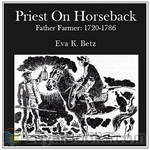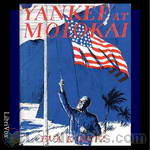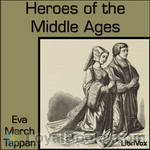|
Books Should Be Free Loyal Books Free Public Domain Audiobooks & eBook Downloads |
|
|
Books Should Be Free Loyal Books Free Public Domain Audiobooks & eBook Downloads |
|
Biographies |
|---|
|
Book type:
Sort by:
View by:
|
By: Eugene Field (1850-1895) | |
|---|---|
 The Love Affairs of a Bibliomaniac
The Love Affairs of a Bibliomaniac
Do you love books? No, I mean REALLY love books? These series of sketches on the delights, adventures, and misadventures connected with bibliomania (bibliomania is characterized by the collecting of books which have no use to the collector nor any great intrinsic value to a genuine book collector. The purchase of multiple copies of the same book and edition and the accumulation of books beyond possible capacity of use or enjoyment are frequent symptoms of bibliomania.). The author wholeheartedly enjoyed this pursuit all his life and his descriptions are delightful to read... | |
By: Eva K. Betz (1897-1968) | |
|---|---|
 The Man Who Fought the Devil
The Man Who Fought the Devil
Jean Marie Vianney always found it hard to learn. In fact, he made history by receiving a zero as his examination mark after his first year of study in the seminary. But with determination, and with God’s help, he won through. He became a hard-working parish priest and then a pastor – the beloved Cure of Ars.Week by week, year by year, his fame as an advisor and a confessor grew. People flocked from great distances to his little church, and privately, among themselves, they called him “saint”... | |
 Knight of Molokai
Knight of Molokai
Hurricane! Volcano eruptions and fire! Leprosy! Nothing deterred Father Damien from doing the work to which he had been called. Outstandingly big and strong as a boy, he was notably kind as a young man. He needed all his strength and kindness when he went to live at the leper colony of Molokai.This children’s biography of Father Damien of Molokai was written by Eva K. Betz, a prolific Catholic writer of history and biography books for children. (Introduction from an original dust jacket and Maria Therese) | |
 Priest on Horseback - Father Farmer: 1720 - 1786
Priest on Horseback - Father Farmer: 1720 - 1786
A historical novel for children, which tells the story of several months in the life of the then famous Father Farmer, as he traveled a Mass circuit in Pre-Revolutionary, Colonial America. He faced much danger and and adventure, in order to provide the Mass and the Sacraments to Catholics who had not seen a priest in years.Father Farmer was a real life missionary priest during the 1700’s in what is now New England. In 1779 he was appointed as one of the first trustees of the University of Pennsylvania. He also had a reputation as a philosopher and astronomer in his time, and was a member of the American Philosophical Society. (Introduction by Maria Therese)No on-line text available. | |
 Yankee at Molokai
Yankee at Molokai
As a daring soldier in the Union Army, Ira Dutton earned the respect and affection of the men around him. Handsome and affable, he could have had a full social life when the war was over. But he felt that his "wild years" demanded atonement - and where could that better be found than in Molokai, where the ailing Father Damien needed help?So he made a free gift of himself, his strength and his capacity for love. Deeply patriotic, he cultivated in his charges devotion to America. A vivid exciting story. | |
 The Quiet Flame
The Quiet Flame
“You will never be a leper nor will any Sister of our Order.”The amazing promise was made by Mother Marianne of Molokai, the “Quiet Flame” of the this title who, as a Sister of St. Francis , spent 30 years on that island helping lepers during and after the time of Father Damien.Mother was speaking to a young nun, and she spoke the truth. Not one of the Sisters ever did contract the disease, a notable fact considering the tender care they fostered on the lepers.This story of this good nun, was written by the author of a number of Catholic biographies and fiction books for children. | |
By: Eva March Tappan (1854-1930) | |
|---|---|
 Heroes of the Middle Ages
Heroes of the Middle Ages
“The object of this book is to bring together stories of the most important movements in the history of Europe during the Middle Ages, and to make familiar the names of the most important figures in those scenes. I have endeavoured to weave a tapestry in which, with due colour, may be traced the history of the rise and fall of the various nationalities and the circumstances and mode of life of each—in short, to give the young reader an approximation to the background for the study of his country’s history which a wide reading gives to a man.” | |
By: Evans, A. J. (1889-1960) | |
|---|---|
 The Escaping Club
The Escaping Club
Described by some as one of the greatest escape books published. The Escaping Club recounts Evans' escape to Switzerland from a supposedly "escape-proof" German prison camp during World War I. After repatriation and rejoining the war, Evans again finds himself captured, this time first by Arabs and then by Turks. He again manages to escape. A detailed look at the trials faced by Allied POWs during World War I. | |
By: Experience Mayhew (1673-1758) | |
|---|---|
 Indian Converts of Martha's Vineyard, in New-England
Indian Converts of Martha's Vineyard, in New-England
This work is actually two "essays" which circulated together, one addended to the other. The first, Indian converts: or, Some account of the lives and dying speeches of a considerable number of the Christianized Indians of Martha's Vineyard, in New-England, is written by Experience Mayhew. Experience was one in a long line of missionary ministers to the Wampanoag Indians on Martha's Vineyard. This work is essentially a treasure trove of small biographies of Native Americans and their amazing faith in God, despite enormous persecution by their fellow man... | |
By: F. J. Foakes-Jackson (1855-1941) | |
|---|---|
 Social Life in England 1750-1850
Social Life in England 1750-1850
In 1916, the Cambridge historian, F.J. Foakes-Jackson braved the wartime Atlantic to deliver the Lowell Lectures in Boston. In these wide-ranging and engaging talks, the author describes British life between 1750-1850. There are John Wesley's horseback peregrinations over thousands of miles of English countryside. Next, Foakes-Jackson introduces the mordant rural poet, George Crabbe, who began life as a surgeon apothecary and ended up as a parish rector who made house calls. He gives us a female convict, assorted Cambridge University dons, Regency fops and rakes, and Victorian slices of life from Dickens and Thackeray... | |
By: Fanny Stenhouse (1829-1904) | |
|---|---|
 ''Tell It All'': The Story of a Life's Experience in Mormonism
''Tell It All'': The Story of a Life's Experience in Mormonism
Fanny relates the experiences of a 19th century missionary as she and her young husband proselytize throughout Europe in search of converts to the new Mormon faith. Her religious zeal is sorely tested upon receipt of news from America revealing that their religion has adopted the practice of polygamy as the means to exaltation. The couple is summoned to Utah only to find themselves firmly ensconced in Brigham Young's inner circle and called upon to practice plural marriage or risk a fall from family, friends, and faith. - Summary by Spiffycat | |
By: Ferdinand Schmidt (1816-1890) | |
|---|---|
 George Washington
George Washington
Among all the numerous life stories written by Ferdinand Schmidt for the delectation and education of German youth, none surpasses that of Washington. The author has condensed his material, drawn from the most authoritative sources, in a masterly manner, and presents it in a very attractive form. He has accompanied it by moralization which is pertinent, but never becomes tedious. It is questionable, indeed, whether any story of Washington’s life written for young people excels Schmidt’s in accuracy, conciseness, and general interest... | |
By: Flavius Josephus (37 - c.100) | |
|---|---|
 Minor Works of Josephus
Minor Works of Josephus
There are 3 parts to this collection.(1) Against Apion is a two-volume defense of Judaism as classical religion and philosophy, stressing its antiquity, as opposed to what Josephus claimed was the relatively more recent tradition of the Greeks. Some anti-Judean allegations ascribed by Josephus to the Greek writer Apion, and myths accredited to Manetho are also addressed.(2) Discourse To The Greeks Concerning Hades describes the author's views on the afterlife against the prevailing view of the "Greeks" (i... | |
By: Flavius Philostratus | |
|---|---|
 The Life of Apollonius of Tyana
The Life of Apollonius of Tyana
Apollonius of Tyana (ca. 40-120 AD) was a Greek Pythagorean philosopher and teacher. He hailed from the town of Tyana in the Roman province of Cappadocia in Asia Minor. His date of birth is a matter of conjecture as some say he was roughly a contemporary of Jesus.After Apollonius' death his name remained famous among philosophers and occultists. In a "novelistic invention" inserted in the Historia Augusta, Aurelian, at the siege of Tyana in 272, was said to have experienced a visionary dream in which Aurelian claimed to have seen Apollonius speak to him, beseeching him to spare the city of his birth... | |
By: Florence Mary Capes (1845-1932) | |
|---|---|
 St. Rose of Lima: The Flower of the New World
St. Rose of Lima: The Flower of the New World
Saint Rose of Lima, T.O.S.D. (April 20, 1586 – August 24, 1617), was a Spanish colonist in Lima, Peru, who became known for both her life of severe asceticism and her care of the needy of the city through her own private efforts. A lay member of the Dominican Order, she was the first person born in the Americas to be canonized by the Catholic Church. | |
By: Frances A. Fuller Victor (1826-1902) | |
|---|---|
 Eleven Years in the Rocky Mountains and Life on the Frontier
Eleven Years in the Rocky Mountains and Life on the Frontier
This lively book follows the adventures of mountain man Joe Meek, from his joining the Rocky Mountain Fur Company trapping expedition in the year 1829 at the young age of 18, through his retirement from public life after serving as Marshall of Oregon Territory. Meek had close connections with many famous people of the era, such as Kit Carson, William and Milton Sublette, Jedediah Smith, Marcus and Narcissa Whitman, Dr. John McLaughlin, Oregon’s Governor Lane, and President James Polk. The author’s information came directly from interviews with Joe himself... | |
By: Frances Alice Forbes (1869-1936) | |
|---|---|
 Life of St. Vincent de Paul
Life of St. Vincent de Paul
Vincent De Paul [c. 1581 - 1660] was a man renowned during his own century for his compassion, humility and generosity. During the days when galleys were part of any countries' war machine and these galleys were rowed by convicts who were in reality slaves, Vincent's special call was to provide what spiritual comfort he could to these wretched men. When a young man he himself had been captured by Turkish pirates, who brought him to Tunis and sold him into slavery, so he had a special understanding of their lot... | |
 Saint Athanasius: The Father of Orthodoxy
Saint Athanasius: The Father of Orthodoxy
A short and rather old fashioned biography a great saint. Don't expect subtlety; it's unapologetic hagiography. The saint is presented as a figure of pristine brilliance, courage and integrity and his persecutors as conniving villains. But to those who appreciate what was at stake in the controversy, Athanasius is indeed a God-sent hero. This is an informative, if quaint, introduction to a fascinating figure in history. | |
 Life of Saint Columba Apostle of Scotland
Life of Saint Columba Apostle of Scotland
Saint Columba (521 – 597) was an Irish abbot and missionary credited with spreading Christianity in present-day Scotland. He founded the important abbey on Iona, which became a dominant religious and political institution in the region for centuries. He is the Patron Saint of Derry. He was highly regarded by both the Gaels of Dál Riata and the Picts, and is remembered today as a Christian saint and one of the Twelve Apostles of Ireland.Columba reportedly studied under some of Ireland's most prominent church figures and founded several monasteries in the country... | |
 Pope Pius the Tenth
Pope Pius the Tenth
Pope Saint Pius X (2 June 1835 – 20 August 1914), born Giuseppe Melchiorre Sarto, was Pope from 4 August 1903 to his death in 1914. He was the first pope since Pius V (1566 to 1572) to be canonized. St. Pius X is known for vigorously opposing modernist interpretations of Catholic doctrine, promoting traditional devotional practices and orthodox theology. His most important reform was to publish the first Code of Canon Law, which collected the laws of the Church into one volume for the first time. He was also considered a pastoral pope, in the sense of encouraging personal holiness, piety and a daily lifestyle reflecting deep Christian values. | |
 Life of Saint Monica
Life of Saint Monica
| |
 Saint Benedict
Saint Benedict
Saint Benedict of Nursia (c. 480 – 543 or 547) is honoured by the Catholic Church as the patron saint of Europe and students. Benedict founded twelve communities for monks at Subiaco, Italy (about 40 miles (64 km) to the east of Rome), before moving to Monte Cassino in the mountains of southern Italy. One of his most well known achievement is his "Rule of Saint Benedict", containing precepts for his monks. He is often called the founder of western monasticism. | |
 Life of St. Ignatius of Loyola
Life of St. Ignatius of Loyola
Saint Ignatius of Loyola (1491– 1556) was a Spanish knight from a local Basque noble family, hermit, priest since 1537, and theologian, who founded the Society of Jesus (Jesuits) and was its first Superior General. After being seriously wounded in the Battle of Pamplona in 1521, he underwent a spiritual conversion while in recovery. De Vita Christi by Ludolph of Saxony purportedly inspired Loyola to abandon his previous military life and devote himself to labour for God. He died in July 1556, was beatified by Pope Paul V in 1609, canonized by Pope Gregory XV in 1622, and declared patron of all spiritual retreats by Pope Pius XI in 1922. | |
 Life of St. Teresa
Life of St. Teresa
Teresa of Ávila, also called Saint Teresa of Jesus, baptized as Teresa Sánchez de Cepeda y Ahumada (28 March 1515 – 4 October 1582), was a prominent Spanish mystic, Roman Catholic saint, Carmelite nun, an author of the Counter Reformation and theologian of contemplative life through mental prayer. She was a reformer of the Carmelite Order and is considered to be a founder of the Discalced Carmelites along with John of the Cross.In 1622, forty years after her death, she was canonized by Pope Gregory XV and on 27 September 1970, was named a Doctor of the Church by Pope Paul VI... | |
 Life of Saint Paul
Life of Saint Paul
A short biography of Saint Paul, the Apostle of the Gentiles, from the time of his persecution of the Christians to his martyrdom. | |
By: Frances M. A. Roe | |
|---|---|
 Army Letters from an Officer's Wife, 1871-1888
Army Letters from an Officer's Wife, 1871-1888
"There appeared from the bushes in front of me, and right in the path, two immense gray wolves . . . Rollo saw them and stopped instantly, giving deep sighs, preparing to snort, I knew . . . To give myself courage, I talked to the horse, slowly turning him around . . . when out of the bushes in front of us, there came a third wolf! The situation was not pleasant and without stopping to think, I said ‘Rollo, we must run him down - now do your best’ and taking a firm hold of the bridle, and bracing myself in the saddle, I struck the horse with my whip and gave an awful scream... | |
By: Frances Ridley Havergal (1836-1879) | |
|---|---|
 Kept for the Master's Use
Kept for the Master's Use
The memoirs of Frances Ridley Havergal, a great missionary and hymn writer. | |
By: Francis Asbury (1745-1816) | |
|---|---|
 Journal of Francis Asbury, Volume III
Journal of Francis Asbury, Volume III
As one of the first two bishops of the Methodist church in America and one of the most well-known circuit riders during the spread of Methodism, Francis Asbury kept a journal of his travels and activities. His journal begins with his prayerful decision to come to America in 1771 and continues to December of 1815, a few months before his death. In the meantime, we travel with Rev. Asbury across the ocean, over mountains, through rivers, and up and down the whole length of the fledgling United States of America. - Summary by Devorah Allen | |
 Journal of Francis Asbury, Volume II
Journal of Francis Asbury, Volume II
As one of the first two bishops of the Methodist church in America and one of the most well-known circuit riders during the spread of Methodism, Francis Asbury kept a journal of his travels and activities. His journal begins with his prayerful decision to come to America in 1771 and continues to December of 1815, a few months before his death. In the meantime, we travel with Rev. Asbury across the ocean, over mountains, through rivers, and up and down the whole length of the fledgling United States of America. Summary by Devorah Allen | |
By: Francis Johnson (1837-1908) | |
|---|---|
 Famous Assassinations Of History
Famous Assassinations Of History
It has been the object of the writer to make each of these “famous assassinations” the central scene of a picture in which the political, religious, or national features of the epoch in which the assassination occurred are portrayed with historical fidelity and strict impartiality…. Only those assassinations have been included which either had an important and political bearing on the world, or on the nation immediately affected, or which left a profound, and, it would seem, indelible impression on the imagination of contemporaries and posterity. - Summary by Book Preface | |
By: Francis Tiffany (1827-1908) | |
|---|---|
 Life of Dorothea Lynde Dix
Life of Dorothea Lynde Dix
A biography of a woman who advocated for the humane treatment of people with mental illness. As a young woman travelling overseas, Dorothea Dix met with people who were interested in reforming how the mentally ill were treated. Returning to America, she pushed for changes and proper care for these individuals, meeting with strong resistance. Her work ultimately resulted in social reform and the creation of asylums. Dorothea Dix was a tireless crusader and instrumental in important social reforms in the United States and the world. - Summary by Phyllis Vincelli | |
By: Frank Berkeley Smith (1869-1931) | |
|---|---|
 Real Latin Quarter
Real Latin Quarter
"Cocher, drive to the rue Falguière"--this in my best restaurant French. The man with the varnished hat shrugged his shoulders, and raised his eyebrows in doubt. He evidently had never heard of the rue Falguière. "Yes, rue Falguière, the old rue des Fourneaux," I continued. Cabby's face broke out into a smile. "Ah, oui, oui, le Quartier Latin." And it was at the end of this crooked street, through a lane that led into a half court flanked by a row of studio buildings, and up one pair of dingy waxed steps, that I found a door bearing the name of the author of the following pages--his visiting card impaled on a tack... | |